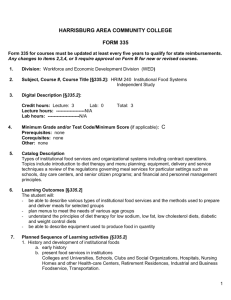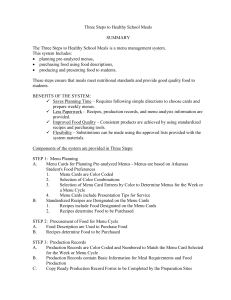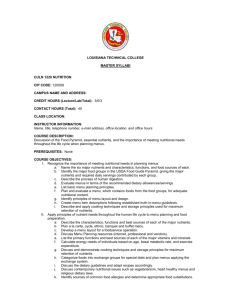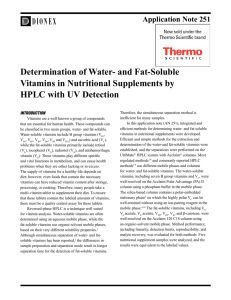Lesson Design
advertisement
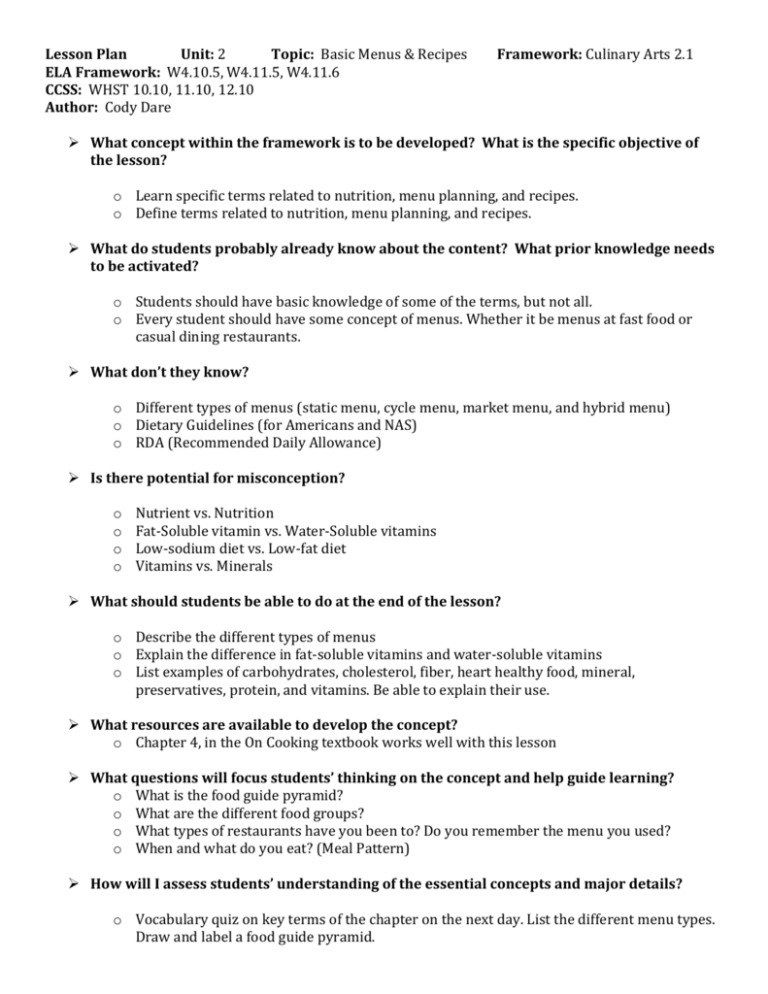
Lesson Plan Unit: 2 Topic: Basic Menus & Recipes ELA Framework: W4.10.5, W4.11.5, W4.11.6 CCSS: WHST 10.10, 11.10, 12.10 Author: Cody Dare Framework: Culinary Arts 2.1 What concept within the framework is to be developed? What is the specific objective of the lesson? o Learn specific terms related to nutrition, menu planning, and recipes. o Define terms related to nutrition, menu planning, and recipes. What do students probably already know about the content? What prior knowledge needs to be activated? o Students should have basic knowledge of some of the terms, but not all. o Every student should have some concept of menus. Whether it be menus at fast food or casual dining restaurants. What don’t they know? o Different types of menus (static menu, cycle menu, market menu, and hybrid menu) o Dietary Guidelines (for Americans and NAS) o RDA (Recommended Daily Allowance) Is there potential for misconception? o o o o Nutrient vs. Nutrition Fat-Soluble vitamin vs. Water-Soluble vitamins Low-sodium diet vs. Low-fat diet Vitamins vs. Minerals What should students be able to do at the end of the lesson? o Describe the different types of menus o Explain the difference in fat-soluble vitamins and water-soluble vitamins o List examples of carbohydrates, cholesterol, fiber, heart healthy food, mineral, preservatives, protein, and vitamins. Be able to explain their use. What resources are available to develop the concept? o Chapter 4, in the On Cooking textbook works well with this lesson What questions will focus students’ thinking on the concept and help guide learning? o What is the food guide pyramid? o What are the different food groups? o What types of restaurants have you been to? Do you remember the menu you used? o When and what do you eat? (Meal Pattern) How will I assess students’ understanding of the essential concepts and major details? o Vocabulary quiz on key terms of the chapter on the next day. List the different menu types. Draw and label a food guide pyramid. Description of Lesson Part of Lesson Before Strategy Admit Slip Cornell Notes Linguistic Vocabulary What Students Will Do What Teacher Will Do Students will be able to write a definition, from prior knowledge or daily experience, to one of the words listed on the board. Teacher will have the list of terms on the board. Using the graphic organizer students will write what they think the definition for the words are and draw a picture representing the meaning to them. Teacher will allow the students time to define and draw a picture of their representation of the word. Either/ Or During How well do I know these words? Lecture Group Discussion On their own, students will put the words into the column that represents their understanding. Then, students will get into groups of two and share their ideas on the meaning of the words. Students will listen and take notes as the teacher presents further detail of the vocabulary words. The class will discuss the deeper meaning of the vocabulary words and their daily meanings. Students will have to answer a question based on class learning during the last five minutes of class on exit slips. After Teacher will give the students time to put the words in to the column that fits their understanding. Exit Slips At home, students will define the vocabulary words, in preparation for an assessment the following day. Teacher will explain and provide models of the different type of menus, different food types, diets, and dietary guidelines. Teacher will be prepared to offer the definition and daily use of any of the vocabulary words that are misunderstood. Teachers should have the exit slip ready. Explain the difference between: Fat-soluble and watersoluble vitamins Vitamins and Minerals Fixed menu and Cycle menu Low-fat diet and low-sodium diet Teacher will be at the door to collect exit slips.


